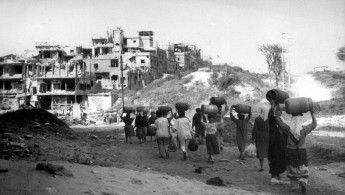Another time, another Beirut
In his new book Following Tracks: Tales of the sites and quarters of the city (Askal Alwan, Beirut), Lebanese writer Fadi al-Tufayli tries to restructure the skeleton image of the Beirut we know today. He sets out on a quest to find the spot where the body of his teacher, Jamil al-Sufuri, ended up during the 1975 to 1990 Lebanese Civil War.
It is an image of a place disturbed by the migration of its people; their regional divisions and party formations. Tufayli also addresses the historical and ethnic facts of their inherited struggles, and the subsequent revivals and devastations of Beirut that have occured again and again throughout history.
| Tufayli does not find the final resting place where his Palestinian teacher was flung by armed militants after being tortured. |
In the book, Tufayli does not find the final resting place where his Palestinian teacher, a Protestant preacher from Zuqaq al-Blat a small district of Beirut, was flung by armed militants after being tortured.
Instead, the narrative is driven by Tufayli's pursuit of the tracks left in this district and his detailed accompanying explanations. He uncovers for us the former Beirut, the city as it appears in ancient maps, with its original subdivisions and ancestral palaces.
Tufayli discusses the significance of the oldest cemetery in Zuqaq al-Blat, El Bachoura, both from an architectural and geographical perspective, including its strategic, raised position. He also discusses its role in defining the military and strategic borders between warring factions. During the civil war El Bachoura was reinforced with two new graveyards in the city - Martyrs' Cemetery and the Garden of Martyrs.
Yet the writer quietly and obediently bears his "failure" to uncover the place of his teacher's remains. The case is certainly not closed, and Tufayli resumes his search: this time focusing on all the political and demographic transformations witnessed by Beirut between 1981 and 2008. Tufayli uses his so-called "failure" to draw a parallel between a human corpse and the body of the city - both of which are in an eternal state of change.
In the writer's mind, his teacher's body could be in more than one place in Zuqaq al-Blat. In this sense, his corpse acquires a sense of mobility, continually evading any attempts to grasp its secret. It is an image we can charge with symbolism, or perceive from a pure political and humanist stance. His body can be conceptually equated with any other body from any other period, as is the case with the character Yousef al-Helou, who died in 1975, and the indications as to his place of death.
With Tufayli's exploration of the terrain of "his Beirut", we do not only see multiple places springing out of one single location. We also observe the reproduction of characters: Saleh al-Yahfouf, Rabah Subhi, Ibrahim al-Nimr, and, towards the end of the book, Yousef al-Helou. This technique of propagation is functional: the characters are all linked in one narrative chain, changing in tandem with their location, and each one, in his own way, peering down over the death of Sufuri.
| The relationship of these characters with the city grants them scope for expression or even defines their existence. |
Moreover, the relationship of these characters with the city grants them scope for expression or even defines their existence. Certain parts of Beirut are converted to environments where the characters cling together in battle, lurk in the shadows, or simply pursue their wartime professions.
However, severing this interaction with the city is of no benefit to the characters, who gradually melt into their surroundings. They do not exist as human beings, but rather as geographical entities. They are a pivot for continuous change, alongside the changing prosperity of the city in its turn. In this way, events are dictated by the repeated shifts in setting, for the characters of the book fade out when they cannot be located in a distinct place. Tufayli then replaces them with other characters, people or factions.
Memory of place in Tufayli's book therefore branches into those characters who are frozen in one location, and those who pass successively through it. Political novelty determines the various historical phases of the city.
Through his writing, Tufayli revives the flesh of memory with memory, and happening with happening, within a vibrant visual context which leaves no room for stripping down or immersion in poetic language. All this taken into account, we actually find out that the author himself lives in the US: a long way from Beirut.
Following Tracks is an experimental piece of literature. The first of its kind, in which Tufayli re-creates an 'underground' that has previously been wiped out. It is as if the writer is conspiring against us below the surface of the Beirut in which we live today - a different Beirut - one that emerges from war, fear, threat and death, but yet is much clearer to us. After reading Tufayli's book, you may well feel on the brink of packing up your things and returning to this 'other' Beirut, without hesitation.
This article is an edited translation from our Arabic edition.
Opinions expressed in this article remain those of the author and do not necessarily reflect those of al-Araby al-Jadeed, its editorial board or staff.



